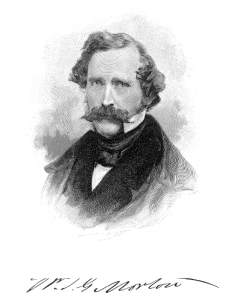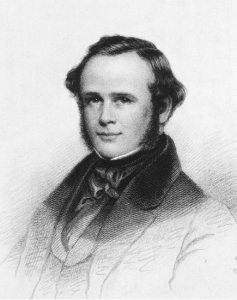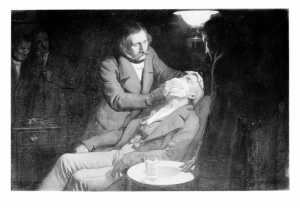American dentist Dr. Horace Wells attempted to bring anesthesia into the world of medicine. However, he failed to do so during a public demonstration on a patient who cried out loudly during the surgery. The agent that Dr. Wells utilized was nitrous oxide, which was removed from the drawing board of potential anesthesia after this failure. Consequently, this event inspired Dr. William. T. G. Morton to find an agent that would actually work. He felt that it was his duty to find a substance that was capable of working as an anesthetic while performing surgeries. The overall execution of surgeries during Dr. Morton’s professional career to this point was seen as inhumane and animalistic. For example, a typical kidney stone extraction would often begin abruptly with a surgeon inserting a metal instrument into a patient’s urethra and then guiding that instrument towards the bladder. While that was happening, the doctor, not able to feel the kidney stone, would try to find it by moving the instrument in all directions. Meanwhile, the patient would be in severe pain. The doctor would hand over the instrument to another surgeon for help. This search would last often several minutes. Dr. Morton wanted to remove this kind of traumatizing and unbearable pain by finding an anesthetic that would eliminate such experiences during surgeries.
Several doctors throughout the country had experimental information that would contribute to the discovery of such a numbing agent. Of these individuals, some might even argue that it was either Dr. Horace Wells, of Hartford, Connecticut, or Dr. Charles Jackson, of Boston, who should have received the credit for anesthesia. These dedicated professionals worked at the same objective, and to some extent, collaborated during the process. However, because of fear or lack of appreciation towards the material, it wasn’t until Dr. Morton demonstrated the possibilities of ether that a true solution to the problem of pain in surgeries was solved.1

Dr. Morton was born in Charlton, Worcester County, Massachusetts. Growing up, he always portrayed higher intelligence than the ordinary and had aspirations of becoming a physician. Despite his intellectual capacity, young Morton had insufficient funds, which prevented him from pursuing his dream profession. Consequently, he was constantly shifting from one job to another. He eventually grew weary of having a commercial career, so he decided to obtain a profession in the dentistry field, even though that field was not his original aspiration. According to Dr. Chapin A. Harris, the field of dentistry was crowded with ignorant and illiterate individuals who made the overall profession greatly suffer. Efforts of genuine men like Dr. Morton impacted the field of dentistry for the greater good, such as bringing public awareness to the importance of dental hygiene. Dr. Morton attended the Baltimore College of Dental Surgery and was one of the institution’s first graduates. During his time there, he met Dr. Horace Wells, and they set up a partnership in Boston. However, there was not enough business for both of them there, so they ended up parting and going their own ways. Dr. Wells left to Hartford and Dr. Morton stayed in Boston.2

Dr. Horace Wells experimented with a substance called nitrous oxide, famously known as “laughing gas.” Nitrous oxide is a colorless, sweet smelling gas used as an anesthetic, most commonly used during dental procedures. It contains sedative properties that aid in relaxation and calming the body once inhaled by the patient.3 When this substance is inhaled by the patient, it can produce funny behavior, which can be quite amusing to an audience. Hence, the connotative name, “laughing gas.” The properties of nitrous oxide intrigued Dr. Wells and led him to perform a private demonstration on December 11, 1844. As a result of this private demonstration, he discovered that his patient was induced and could not feel any physical pain. Dr. Wells continued to experiment with this substance on his own patients, and later had one of his own teeth removed by Dr. John M. Riggs while under this sedative substance. This became known as the first recorded instance of a patient under the influence of nitrous oxide. After experimenting for quite a while, early in 1845, Dr. Wells was given the opportunity to make a public demonstration of a tooth extraction. Colleagues intrigued by the benefits of nitrous oxide attended the demonstration. Dr. Wells nervously began with the procedure and administered the gas to the patient. The surgeon proceeded with the extraction of the tooth when the patient went unconscious. However, due to poor equipment of haphazard administration, things did not go as planned. The patient awoke during the surgery and was anxiously yelling loudly. Dr. Wells felt extremely humiliated as the audience made rude remarks after the incident. Later on, the patient admitted that he felt no pain during the surgery, but the public still had their own opinions and continued to discredit Dr. Wells. He lacked a lot of experience and fell into deep depression, leading him to retire from practice and he later committed suicide.4
Dr. Morton, on the other hand, seemed to be prospering after parting ways from Dr. Wells. He was, in fact, one of the best known practitioners in Boston and kept improving his dental technique. Work was coming in quickly for him so that he even had to hire several assistants. Although he was very successful in his profession, he was still not satisfied with his medical education and kept seeking for more. Therefore, he decided to further his education and attend Harvard Medical School, where he was asked to choose a professional as a preceptor or guide. He chose Dr. Charles T. Jackson, who had a major influence on his discovery of ether. Dr. Morton discussed with Dr. Jackson his interests in an agent that had the ability of alleviating pain during surgeries. Dr. Jackson shed light on several drugs that could be potential agents. One of the drugs brought to the drawing board was sulfuric ether, which could be applied locally over sensitive tissue. Dr. Morton was swayed into learning more about the properties of ether. He did a lot of research on it, and he set himself to learning all the properties of this substance. The possibilities of this being a potential agent became an obsession for him, and he started experimenting with it on small animals and even on himself. There was even a time where he became severely ill from inhaling fumes of both ether and opium together. He was conducting all these experiments, his dental practices, and coursework in medical school simultaneously. Juggling his busy schedule, Dr. Morton attracted the eyes of many in astonishment as to how he was able to handle it all.5
On September 30, 1846, he successfully administered ether on a patient for an extraction of a tooth. He felt confident about this agent and was ready to show the world via public demonstration. He was well aware of the humiliation Dr. Wells went through, but he was willing to jeopardize his reputation. He went to Dr. John Warren, a professor of surgery at the medical school, and asked for permission to apply ether on a patient at a surgical clinic at the Massachusetts General Hospital. Dr. Warren knew who Dr. Morton was and had a good opinion of him, so he gave his consent. The Massachusetts General Hospital is known as the largest and best hospital in Boston. However, the surgical and antiseptic rooms at the time were nothing compared to the hospitals we have today. The hospital rooms consisted of hooks, rings, pulleys, and oddly shaped surgical instruments, which portrayed the brutality of surgery during this time period. Dr. Warren set a date for October 16, 1846. There were many angry discussions and people who doubted Dr. Morton as they expected another infamous repetition of Dr. Wells’ public demonstration. The concerned public claimed that Dr. Morton was only a dentist and a medical student, and that the potential demonstration was simply setting him up for public failure.6
The day finally came and Dr. Morton did not show up at the specified start time. Dr. Warren was beginning to think that Dr. Morton had failed him. Shortly after doubt creeped in, Dr. Morton arrived. The patient gave consent to have anything done to remove the pain during the surgery, and with simple preparation, the procedure began. Dr. Morton administered the ether from a bottle with a long snout, which was positioned over the patient’s mouth for him to inhale. The patient lapsed into a deep sleep. Dr. Morton turned over to Dr. Warren and said, “Your patient is ready, sir.”7 There was complete silence, as the colleagues gathered around were completely astonished. Dr. Warren triumphantly removed a vascular tumor from the patient’s neck.8 After the surgery, the patient said he did not feel any pain during the whole procedure, and Dr. Morton proved to be successful.9

The news spread rapidly and Dr. Morton was asked to administer ether for many other surgeries. He received plethora of both recognition as well as criticism. He was surrounded by plenty of jealous medical men, who began protesting and attempting to discredit him. He and his wife received an abhorrent amount of humiliation, and it got to a point where it was no longer safe for him to be out in public. Lawmakers received several claims and counter-claims that they were incapable of coming to an agreement. Therefore, neither credit nor recognition was given to Dr. Morton for his work. Regardless, he received a gold medal from the French Academy of Sciences, along with an honorary medical degree from an American university. Dr. Morton sacrificed his reputation and happiness so that people could be freed from pain, which is why his name should be ranked as one of the great Americans of Medicine. He was a brave individual and for that he should be given the credit that is his due.10
- C. A. H. Smith, “The Discovery of Anesthesia,” The Scientific Monthly 24, no. 1 (1927), 65. ↵
- C. A. H. Smith, “The Discovery of Anesthesia,” The Scientific Monthly 24, no. 1 (1927), 65. ↵
- Cindy F. Ovard RDA, “Nitrous Oxide,” in The Gale Encyclopedia of Nursing and Allied Health, ed. Jacqueline L. Longe, 4th ed., vol. 5 (Farmington Hills, MI: Gale, 2018), 2355. ↵
- Lyzette Flores, “The Four Men Who Helped Shape Medicine,” StMU Research Scholars (blog), December 6, 2018, https://stmuscholars.org/the-battle-of-anesthesia/. ↵
- C. A. H. Smith, “The Discovery of Anesthesia,” The Scientific Monthly 24, no. 1 (1927): 66. ↵
- C. A. H. Smith, “The Discovery of Anesthesia,” The Scientific Monthly 24, no. 1 (1927): 67. ↵
- C. A. H. Smith, “The Discovery of Anesthesia,” The Scientific Monthly 24, no. 1 (1927): 68. ↵
- Albert Lorber and hTomas W. Pomeroy Jr, “USE OF ETHER DUE TO DENTIST; William Green Morton Has Been Erroneously Listed as a Physician WE ARE SHIRKING,” The New York Times, November 23, 1930, sec. Archives, 50. ↵
- Lyzette Flores, “The Four Men Who Helped Shape Medicine,” StMU Research Scholars (blog), December 6, 2018, https://stmuscholars.org/the-battle-of-anesthesia/. ↵
- C. A. H. Smith, “The Discovery of Anesthesia,” The Scientific Monthly 24, no. 1 (1927): 69-70. ↵



16 comments
Kayla Braxton-Young
This is a really interesting and important topic. I really didn’t know that a numbing substance would have changed the world. When I think about numbing, I think about a cavity or a tattoo, or surgery. With cavities they numb your mouth so you don’t feel the needle they are using when removing the cavity, there is numbing cream so you don’t feel the tattoo needle, when getting a tattoo, and there is numbing cream and medicine they use to put you asleep for surgery. I really enjoyed reading this article and the different things about numbing substances.
Dylan Vargas
The article is good and I like how it gives a background at the beginning but I wish they talked about Dr. Morton early. Like where he was born and more so we can get that out of the way besides having it in the middle of the section. Besides that, the article is well put and I like how the sources are very relevant and give concert support for his article and the topic about Dr. Morton. I also like the topic itself, anesthesia really did change the world. When I read the title, I was not excepting this sort of topic but I am glad I read the article.
Seth Roen
Great article, Natalia, on medical history, in particular, the relatively recent discovery of ether. I did not know that the father of numbing agents, Dr. Morton, started to find painkillers in dentistry, a field he was not initially trained to practice, but if you need money, you will do anything. Just imagine the ordeal that a person would have to go through to get better. It seems like, at a certain point, medical procedure turns into torture.
Alexandra Camarena
This was an incredibly interesting article! Not many of us even remember that there was a time when anesthesia wasn’t available. I simply cannot imagine undergoing surgery without being completely knocked out or with any type of anesthetic. I really liked how the author focused on the background information because it laid the foundation for the rest of the article.
Samuel Vega
Natalia, I had limited knowledge on the topic that you selected on ether. I found your article to be very information on the beginnings of anesthesia. I appreciated the explanation of the early contributions of Dr. Wells and Dr. Norton to the beginnings of anesthesia. Understanding the early contributions allows me to see how far we have come in specialized disciplines within medicine.
Halie Estrada
First of I would just like to say this was a very interesting article, I never knew the true origins of anesthesia. Like you said in the end of the article I believe Dr. Morton deserves the recognition for his work and bravery to stand up against the people during this time period. After what happened to Dr.Wells I think it’s crazy anyone would try again but because he felt so strongly about his profession and the flaws in it he took the chance. The chance of failure and a damaged reputation he chose to do what he thought was the right thing. Because of him we now have anesthesia and I wish I could personally thank him because there’s no way I would’ve been able to get through some of the surgeries i’ve had to have without it!
Jordan Davenport
What a fantastic title for a fantastic article. You have done a great job explaining the contributions Dr. Morton made in the medical field. I enjoyed his backstory and how through the ups and downs, a very important idea of his changes the world for the better. There is a better way to perform medical operations with the use of ether and anesthesia thanks to Dr. Morton
Sophia Phelan
This is such an amazing invention, and I definitely hadn’t ever thought of it as something that needed to go through the trial and error phase of development.
Grace Malacara
Dr. Morton deserves to be recognized for his major contributions to the medical world. It’s amazing how many people would criticize something new or unusual, yet his contribution was hugely beneficial. Despite progress toward a less grueling and agonizing surgical procedure, there were still others who did not appreciate his efforts. Additionally, the images you placed throughout the essay were quite interesting and compelling. Congratulations on your nomination and great work!
Cassidy Colotla
Natalia, what a lovely article!
It’s crazy to think how far medicine has come. Before reading the article I did not know much about anesthesia but I did however know about the painful procedures that took place before anesthesia was invented.
I think it says a lot about something that Dr. Morton saw the pain of his patients and wanted to do something about it.
It was unfortunate that it did not work out for Dr. Wells at first as he was just trying to do the same.
This really has granted us the possibility to perform many surgeries and allowed for many medical advances.